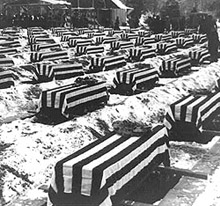Traveling within the World
Linking your favorite traveling artists across the globe
"The House of Mourning"
Victorian Mourning & Funeral Customs in the 1890s
BEFORE THE FUNERAL:
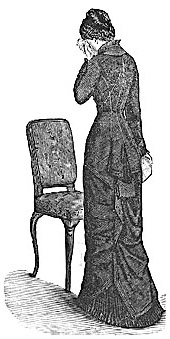
"He wraps the drapery of his couch about him,
And lies down to pleasant dreams."
WATCHING THE DEAD:
It is no longer the custom to watch the dead — an excellent omission, for many of those vigils were unseemly in their mirth. Some friend or relative sits up in order to give the dead any attention necessary. The preparation of the deceased is always attended to by some kindly friends who are not members of the family, and that agonizing duty is spared the afflicted ones. It is more thoughtful for someone to volunteer to remain with the family, through the long sad night hours. It makes the grief and loneliness of the house less oppressive.
CRAPE ON THE DOOR:
"Ring the bell softly,
There's crape on the door."
Black crape tied with white ribbon is placed upon the door or bell knob, as an indication that the dread visitor has entered the home, and borne away another prize. This should deter the caller from ringing, if it is possible to bring the attendant to the door without doing so. No one knows save those who have passed through a sorrow, how the clang of a bell, with its noisy reminder of active life, jars upon the nerves. In many houses, the hall door is left ajar, that friends may enter quietly. The kindly instincts of the heart tell them to speak softly, and be helpful and sympathetic. White crape looped with white ribbon is appropriate for a child or young person. For the aged, black crape and black ribbon are used.
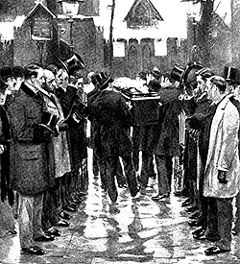
From six to eight pall-bearers are chosen from the immediate friends of the deceased, and near to him in age. A very young girl may be conveyed to the hearse by girls of her own age. The duty of the pall-bearers is to carry the coffin from the house to the hearse — also from the hearse to the grave. The carriage in which they ride precedes the hearse. They are provided with black gloves and crape for the arm, when attending an elderly person, but wear white gloves and white crape for a young person. These are furnished by the family through the undertaker. Notes are sent to those who are to act in this capacity, requesting their services.
AT THE HOUSE OF MOURNING:
When the sad event has become known, friends call to offer their services, but the afflicted ones are not expected to see any save their most particular friends, whose duty it is to make all arrangements for the burial, consulting with those most interested about the details, receive those who call, or fulfill any and every requirement that may arise. Visits of condolence are not made until after the funeral.

The family decides about how many it wishes to invite to the interment, and provides carriages for them. A list is made out, and given to the undertaker, that he may know about how many carriages will be needed, and in what order to arrange them. Many bring their own carriages, but a certain number is provided by the family, among which are those for the pall-bearers, and clergyman, when he accompanies the dead to the grave.
FUNERAL INVITATIONS:
In cities and towns where death notices are inserted in the papers, the words "Friends invited," is sufficient invitation to the funeral. But in smaller places, it becomes necessary to issue invitations to those whose presence is desired. The invitations are engraved on small-sized note paper, with wide black border, in this manner:
"Yourself and family are respectfully invited to attend the funeral of Miss Stella Mason, from her late residence (number of residence or the church, if the services are to be held there may be placed here) on Wednesday, July 14th, at 11 o'clock A. M . Burial at Forest Home Cemetery." |
Do not slight an invitation to a funeral.
FUNERAL SERVICES:
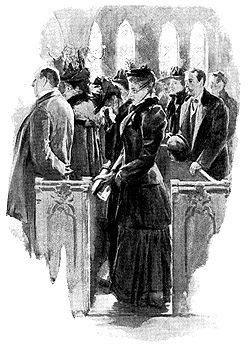
Those who are present should look at the dead before they take their seats for the service, although it is customary for the master of ceremonies (usually the undertaker) ere the coffin lid is closed, to invite all who so desire, to take a last look, ere parting forever.
The casket is never opened at the church, unless it is the funeral of a prominent man and numbers go to the church for that purpose, whom the house would not accommodate.
The family, together with those who are to be present at the interment, should be allowed to pass from the house or church before the others do.
"FUNERAL PRIVATE":
This announcement has caused many to remain away from a funeral, lest they intrude. But it merely means that the interment will be private, only a few near friends accompanying the remains to the grave; but at the services all who choose to come will be welcome.
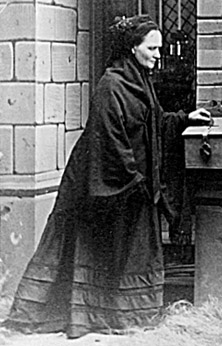
How tenderly these emblems of purity and beauty speak to the mourning heart. They are the tokens of sympathy sent by friends to comfort the lonely ones. Their fragrance mingles with the memory of the dear one who has gone. How fitting that their exquisite beauty and perfume should mingle with the last sad rites and consolation be found by silently breathing the heart's emotions in their blossoms, for
"They are love's last gifts; bring flowers, pale flowers."
ORDER OF FUNERAL:
The carriages containing the clergyman and pallbearers come first. The hearse follows, and behind that are the carriages of the immediate mourners, in their proper order. At the place of burial the minister precedes the coffin. An undertaker who is competent, always directs all the details, so that the family have no part in any such painful duty.
MILITARY FUNERALS:
The sword and sash of an army or navy officer are laid across the coffin lid, and the national flag is draped over him. When the deceased is buried with Masonic or other honors, the lodge or body to which he belongs, conducts the funeral according to its own formulas. In case the deceased is a member of an organization that expects to conduct the services, prompt notice should be sent them, so that they may have time to prepare for the funeral.
HOW LONG MUST MOURNING BE WORN?
A widow's bonnet should be of heavy crape, with white crape or tarletan border, and the veil must be worn over the face. At the end of three months she may wear the veil depending from the 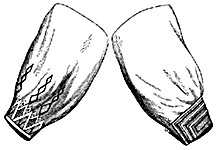
A widower wears mourning for a year. His mourning must consist of a black suit, black gloves and necktie, and a deep weed on his hat. Those are very punctilious in such matters, wear black-edged linen and black studs and cuff-buttons.
For parents or children deep mourning is worn for a year. After that, though mourning is worn another year, the material is changed, and crape is dispensed with.

Crape and soft woolen goods for brothers and sisters are worn for six months; after that gray, black and white can be adopted.
Of course there are no set limits to the period of wearing mourning, for these matters vary with the individual tastes and feelings of the wearer. Custom has laid down certain rules, which, however, can be widely departed from at will.
For uncles, aunts, cousins and grandparents, black suits without crape are worn.

Gentlemen in mourning wear weeds, whose depth is proportioned to the closeness of their relationship to the dead. Their mourning is adhered to only as long as the ladies of their household wear it.
ATTENDING PLACES OF AMUSEMENT:
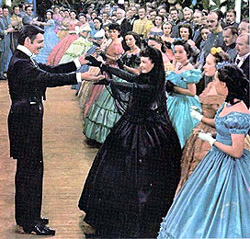
It is not in good taste to attend a funeral in gay colors. You are not expected to assume mourning, but nearly every one has a plain, dark suit that is less noticeable.
WEARING MOURNING:
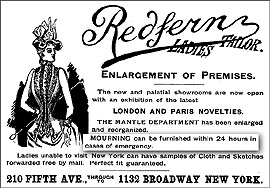
CARDS AND WRITING-PAPER:

MEMORIAL CARDS:
Sometimes the bereaved ones send cards announcing their loss to friends. It is far less harrowing than to write, especially when one's circle of acquaintance is large. They should say very little:
In Memoriam: |
The words "In affectionate remembrance" may be substituted for "In Memoriam."
CALLS OF CONDOLENCE:
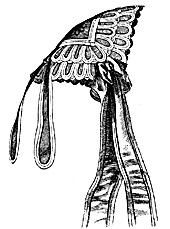
It is best not to allude to the sorrow unless it is seen that it is expected of them to do so. It is a relief with some people to talk of the departed, while it proves a torture to others, and only reopens the wound.
SECLUDING ONE'S SELF:
It is better for the sorrowing ones to mingle with their fellow creatures as soon as they can endure company. Their own feelings are their best guides. To some dispositions seclusion is a sweet and gentle ministry — they are never alone. But to others the monotony and loneliness strike a chill, and they must have some change to keep them from a settled melancholy.
It is not usual to give or attend entertainments within a year of the death of a near relative; but if the custom is broken by the young, it should not excite unkind remarks. Older people should not expect younger ones to observe such strict rules as they lay down for themselves. The "young suffer intensely, but it is a wise provision of nature that it is not as lasting as the grief of maturer years. They should pay a suitable respect for the relatives they have lost; but do not ask them to seclude themselves until their lives are lastingly shadowed. We owe love and remembrance to the dead; but we also owe a duty to the living. And if we would hallow the memory of those we have lost, we should be more tender toward those who are left us to love and cherish.
There's a beautiful face in the silent air The snow-white hand and head of gold There's a sinless brow with a radiant crown, Ah, well! the summer is coming again, There's a beautiful land beyond the skies, |
"What a pleasant thought, that when we come to die people will show us respect, that they will gather round the casket and tenderly lay our remains away in the earth for the angels to watch over till the morning of the resurrection. Tears will fall upon our grave, and appreciative words will be uttered. But would it not be well if honors were not entirely posthumous? if a part of the love and affection that is so freely given to the dead, had encircled them when living?"
I sometimes think that it would be best It seems so far to the wished for day, The night is long, but the day will break —F. L. Stanton. |
from... Polite Society at Home and Abroad, 1891.
Tags:
Replies to This Discussion
Events
-
2014 is the Chinese Year of the Horse
February 17, 2026 at 12am to February 5, 2027 at 12am – where & how you choose
Birthdays
Birthdays Today
Birthdays Tomorrow
Important (read & understand)
Skype: Travelingraggyman
Email and Instant Messenger:
TravelerinBDFSM @ aol/aim; hotmail; identi.ca; live & yahoo
OR
Travelingraggyman @ gmail and icq ***

1AWARD UPDATES & INFORMATION
10,000 votes - Platinum Award
5,000 votes - Gold Award
2,500 votes - Silver Award
1,000 votes - Bronze Award
300 votes - Pewter Award
100 votes - Copper Award
Member of the Associated Posting System {APS}
This allows members on various sites to share information between sites and by providing a by line with the original source it credits the author with the creation.
Legal Disclaimer
***************We here at Traveling within the World are not responsible for anything posted by individual members. While the actions of one member do not reflect the intentions of the entire social network or the Network Creator, we do ask that you use good judgment when posting. If something is considered to be inappropriate it will be removed
Site Meter
This site is strictly an artist operational fan publication, no copyright infringement intended
Patchwork Merchant Mercenaries had its humble beginnings as an idea of a few artisans and craftsmen who enjoy performing with live steel fighting. As well as a patchwork quilt tent canvas. Most had prior military experience hence the name.
Patchwork Merchant Mercenaries.
Vendertainers that brought many things to a show and are know for helping out where ever they can.
As well as being a place where the older hand made items could be found made by them and enjoyed by all.
We expanded over the years to become well known at what we do. Now we represent over 100 artisans and craftsman that are well known in their venues and some just starting out. Some of their works have been premiered in TV, stage and movies on a regular basis.
Specializing in Medieval, Goth , Stage Film, BDFSM and Practitioner.
Patchwork Merchant Mercenaries a Dept of, Ask For IT was started by artists and former military veterans, and sword fighters, representing over 100 artisans, one who made his living traveling from fair to festival vending medieval wares. The majority of his customers are re-enactors, SCAdians and the like, looking to build their kit with period clothing, feast gear, adornments, etc.
Likewise, it is typical for these history-lovers to peruse the tent (aka mobile store front) and, upon finding something that pleases the eye, ask "Is this period?"
A deceitful query!! This is not a yes or no question. One must have a damn good understanding of European history (at least) from the fall of Rome to the mid-1600's to properly answer. Taking into account, also, the culture in which the querent is dressed is vitally important. You see, though it may be well within medieval period, it would be strange to see a Viking wearing a Caftan...or is it?
After a festival's time of answering weighty questions such as these, I'd sleep like a log! Only a mad man could possibly remember the place and time for each piece of kitchen ware, weaponry, cloth, and chain within a span of 1,000 years!! Surely there must be an easier way, a place where he could post all this knowledge...
Traveling Within The World is meant to be such a place. A place for all of these artists to keep in touch and directly interact with their fellow geeks and re-enactment hobbyists, their clientele.
© 2025 Created by Rev. Allen M. Drago ~ Traveler.
Powered by
![]()

